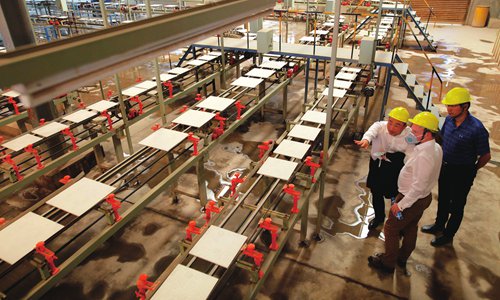
A view of a ceramic tile plant invested by two Chinese firms in Kenya in December 2017 Photo: VCG
Chinese makers of ceramic tiles, a key construction material, may lose their traditional cost advantage to India, while the trade war with the US is inhibiting Chinese export orders, according to a report issued over the weekend.
But it won't be easy for India to surpass China's ceramic tile industry in the short term, because of India's weak infrastructure and ubiquitous labor disputes, experts told the Global Times on Sunday.
"The industry chain is accelerating its shift from China to India, as some clients have moved their sources from China, where producers are facing US tariffs and higher prices. The orders are now going to countries such as India and Vietnam, where they can enjoy tariff rates close to zero," said the report.
A preview of the report, titled "The Transformation and Upgrading of China's Manufacturing Industry - Foshan Situation," was released during the Sanya Forum in Sanya, South China's Hainan Province on Saturday.
"The rise of India's ceramics industry shows that the South Asian neighbor is eating away at China's traditional strength in low-cost manufacturing against the backdrop of the trade war," said Zhang Yansheng, chief research fellow with the China Center for International Economic Exchanges (CCIEE). Zhang was a co-author of the report.
"India can now produce ceramics at a low cost thanks to its massive labor market that is home to 400 million young people aged 15 to 34," Zhang added. But China's cost of production, including such factors as labor and land, is skyrocketing compared with India and Vietnam, Xu Zhaoyuan, a researcher at the State Council Development Research Center, told the Global Times on the sidelines of the Sanya forum.
"China's average salary is three to four times that of Vietnam," said Xu.
The production shift is being exacerbated by financing difficulties faced by small and medium-sized private companies, the report said.
Because of all these factors, in July and August, the aggregate revenue of ceramic tile producers in Foshan, a manufacturing base in South China's Guangdong Province that represents about 85 percent of the nation's output, slid by 18.9 percent year-on-year.
Although India's rise shows the pressure that some Chinese factories are struggling, industry insiders agreed that talk of India or other Asian countries replacing China as the world's factory is premature.
"China may lose its advantage to India in terms of labor cost, but in terms of industry competitiveness, China has an overwhelming edge. That gives producers in China access to the most advanced and complete industry chain, which increases efficiency while reducing costs," Xu said.
That's the key reason why many foreign companies choose to keep their production in China despite facing higher US tariffs.
China is also good at producing equipment for to be used in advanced manufacturing, experts noted. For example, Chinese companies export ceramics equipment to India in bulk, and they take up about 80 percent of the Indian market for this category of equipment, the report said.
It will be difficult for India to surpass China in the ceramic tile industry any time soon because of India's disadvantages when it comes to infrastructure and its frequent labor disputes, said Zhao Gancheng, director of the South Asia Studies Department at the Shanghai Institute for International Studies. "China's ceramic tile industry has been enjoying good cooperation with traditional dominant brands. If these foreign investors move production to India, they potentially face transport and labor problems," Zhao said.
Additionally, China is also a vast market for ceramic tiles, and it will be hard for India to close that gap immediately, despite any impact of the trade war, Zhao said.
In terms of transformation and upgrading, China's manufacturers should focus on high-end markets by upgrading their design and quality, Zhao added.

